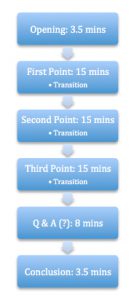How to Structure and Build a Presentation
 Do your presentations wander aimlessly, or are you overwhelmed as to how you might fill a comprehensive presentation of 30 to 60 minutes? We are pleased to present this guest blog by Patricia Morgan, renowned author, speaker, facilitator and speaking coach….
Do your presentations wander aimlessly, or are you overwhelmed as to how you might fill a comprehensive presentation of 30 to 60 minutes? We are pleased to present this guest blog by Patricia Morgan, renowned author, speaker, facilitator and speaking coach….
Why You Need a Presentation Structure
Before you find a way to ramble through with whatever’s at the top of your head, let’s start with why. Why do you need a solid structure to your presentation?
1. Effective presentation structure gives order to your content. If you were to go on a bus tour or nature walk you would be guided from the beginning point to points of interest to the destination. There would be no detours unless for an important reason. Audiences do not like to feel lost or as if the speaker is taking them off track.
2. Structure aids in audience understanding, attention, and ability to remember content. This increases your audience’s motivation to act on your recommendation (to engage in your services). You want the audience leaving saying, “He covered three amazing myths about oil price predicting. What we have been thinking has been nuts. And they made it clear XYZ has the answer.”
3. Structure helps you keep your promise to deliver what was promoted. It can actually develop trust. If your presentation starts on time, gives valuable and understandable information in the time allotted, and ends on time, they will believe you will keep your future business commitments.
4. Structure helps in deciding how much content can realistically fit into the session timeframe. Not enough content risks audience disappointment and too much can result in overwhelm or the session going overtime. Ending two minutes early tends to be a relief and pleasure for audiences.
Developing Your Presentation Content
Content includes all spoken facts, ideas, stories, examples, metaphors, and props, plus slides with words, images, and graphs. It is crucial that the audience understand the relationship of all content to your Title and you’re Main Points, into which your content will be organized. Remember, avoid detours or you will lose your audience.
Points
Each Main Point needs to be articulated clearly, given a title and a quick explanation. It is important to know how much time you have dedicated to each point and the important content. If you say “the key point is” then you should be referring to your main thesis or title. If you say “the important point is” then it should have a title with clear sub-points and be consistent with your PP slides, if using them.
Transition Statements
To help audiences realize you are moving from one Main Point to another Main Point, use a transition statement. This might be something like, “This leads me to…” or “Which is the NEXT big reason for….” This just cues people that you are moving to the next point.
You do not want audience members asking themselves, “What is the point?” Think of a book. It has a Book Title, and then an Introduction followed by Chapter One, then Chapter Two and so on. In non-fiction books, key sub-points also have titles and are highlighted. Comas, periods and paragraphs give the reader structure and pauses between thoughts and new ideas. Speakers need other strategies to give order. You want to guide the audience so they know what page you are on.
Using PowerPoint to Support Structure
PowerPoint is optional. Many audiences are weary of bullet points. Know how to use PowerPoint or Keynote effectively if decide to use. Place each Main Point title on a slide in large font with a number/or letter and one appropriate image. If you use images for Sub-points they need to logically relate to their Main Point and may be numbered as well.
Sample Presentation Structure
 The following is a suggested presentation structure. Yours may be shorter or longer, but timing stays relatively the same.
The following is a suggested presentation structure. Yours may be shorter or longer, but timing stays relatively the same.
OPENING: Time 3.5 min
Title: Your main point (thesis)
Purpose: Tell them what you’re going to tell them. Hook your audience and connect with them. Provide an overview of your proposed main idea, topic and purpose. Memorize your first words. Create a transition statement into the main points.
BODY — Consists of your main points. (Tell them!)
Provide “Must Know” information in 1-7 points. Each point must support your main point (thesis).
Note: keynotes often have only one point.
FIRST POINT: 15 min
Often the Problem or audience Pain or the first of 3 solutions to a problem described in the introduction. Includes sub-points to support the First Point, and a Transition statement to the Second Point.
SECOND POINT: 15 min
Often your solutions or a 2nd solution. Include sub points and a Transition Statement to the Third Point.
THIRD POINT: 15 min
Often How to Apply, or a Third solution. Include Sub-points (or Ways to apply), and a Transition Statement to the Q & A or a Conclusion.
(OPTIONAL) QUESTION AND ANSWER: 8 min
When helpful to the audience, repeat any of the questions over the microphone (if you have one) in a clear sound bite. Answer questions succinctly. Never place ad Q & A at the end of a presentation. You want your words to be the last the audience hears. Transition statement
CONCLUSION: 3.5 min
Conclusion: Tell them what you told them.
Connect back to your main point (thesis).
Sum up your main points and ideas.
Make a call to action.
Memorize your closing words.
And so, to Conclude…
The above structure can be used to develop your coordinated PowerPoint and handouts. You can also use this structure to write out a full script, word by word. Many speakers find a script better allows review and revision of their presentation content, structure and timing. NOT that you should read your presentation, but scripting always helps to clarify your thoughts!
We’d love to hear your thoughts on presentations! Please provide your comments below, or CONTACT US today!



Thanks for this write up Patricia.
I exactly what am looking for on Digital Marketing Presentation
You are most welcome, Ezekiel. Thank you, for leaving your acknowledgment. Let us know how your audience responds to your thoughtful changes.